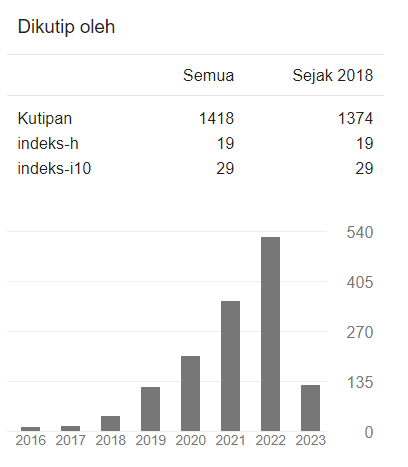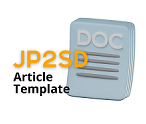Pengelolaan Pembelajaran Berorientasi Literasi Numerasi di Sekolah Dasar dalam Kegiatan Kurikuler dan Ekstrakurikuler
DOI:
https://doi.org/10.22219/jp2sd.v9i2.17906Abstract
Kompetensi literasi numerasi sebagai prasyarat kecakapan hidup di era 4.0 dikembangkan dengan mengintegrasikan pendidikan dalam keluarga,sekolah, dan masyarakat. Penguasaan literasi numerasi menjadi sangat penting tidak hanya bagi siswa, tetapi juga bagi orang tua dan warga masyarakat. Tujuan dalam penelitian ini yaitu: (1) mendeskripsikan kegiatan pembelajaran berorientasi literasi numerasi melalui kegiatan kurikuler di Sekolah Dasar Muhammadiyah Kota Surakarta dan (2) Mendeskripsikan kegiatan ekstrakurikuler berorientasi literasi numerasi di Sekolah Dasar Muhammadiyah Kota Surakarta. Penelitian ini dilakukan melalui tahap: (1) mengidentifikasi masalah dalam pembelajaran literasi numerasi (2) menentukan fokus masalah yaitu pembelajaran literasi numerasi di Sekolah Dasar dalam kegiatan kurikuler dan ekstrakurikuler, (3) menetapkan subyek penelitian, (4) menghimpun data penelitian melalui teknik wawancara, observasi, dan dokumentasi, (5) melakukan analisis menggunakan model alir-interaktif, dan (6) membuat simpulan berdasarkan analisis data dan teori yang ada. Subyek penelitian yang ditentukan adalah kepala sekolah, dua guru kelas V, dan dua penanggung jawab ekstrakurikuler cooking class di SD Muhammadiyah Kota Surakarta. Untuk menguji validitas data penelitian menggunakan triangulasi sumber dan member check. Diperoleh hasil penelitian (1) kegiatan pembelajaran berorientasi literasi numerasi melalui kegiatan kurikuler dilakukan dengan perencanaan (media, bahan belajar,pelaksanaan, dan soal HOTS), pelaksanaan dilakukan secara online dan mandiri, pengendalian melalui kegiatan supervisi dan refleksi. 2) kegiatan ekstrakurikuler yang berorientasi literasi numerasi dilakukan melalui cooking class
Downloads
References
Abdullah, A. A., & Richardo, R. (2017). Menumbuhkan Kemampuan Berpikir Kritis Siswa Dalam Memilih Makanan Sehat Dengan Pembelajaran Literasi Matematika Berbasis Konteks. Jurnal Gantang, 2(2), 89–97. https://doi.org/10.31629/jg.v2i2.193
Adler, J. (2021). Levering change: the contributory role of a mathematics teaching framework. ZDM - Mathematics Education, 0123456789. https://doi.org/10.1007/s11858-021-01273-y
Afiani, K., & Faradita, M. (2021). Analisis Aktivitas Siswa dalam Pembelajaran Daring Menggunakan Ms . Teams pada Masa Pandemi Covid-19. Jurnal Pemikiran Dan Pengembangan Sekolah Dasar, 9(1), 16–27.
Andani, M., Pranata, O. H., & Hamdu, G. (2021). PEDADIDAKTIKA : JURNAL ILMIAH PENDIDIKAN GURU SEKOLAH DASAR Systematic Literature Review : Model Problem Based Learning pada Pembelajaran Matematika Sekolah Dasar. 8(2), 404–417.
Aso, L., Teambo, M., & Zahrani. (2021). Amal Ilmiah : Jurnal Pengabdian Kepada Masyarakat. Sosialisasi Peran Bahasa Daerah Dalam Pencegahan Dan Penangulangan Bahaya Virus Corona, 1(1), 101–107.
Atma, B. A., Azahra, F. F., Mustadi, A., & Adina, C. A. (2021). Teaching style , learning motivation , and learning achievement : do they have significant and positive relationships ? 9(1), 23–31.
Backes, S., Baumann, I., Harion, D., Sattler, S., & Lenz, T. (2021). Why flipping the classroom is not enough: Digital curriculum making after the pandemic. Prospects, 0123456789. https://doi.org/10.1007/s11125-021-09555-9
Bakker, A., Smit, J., & Wegerif, R. (2015). Scaffolding and dialogic teaching in mathematics education: introduction and review. ZDM - Mathematics Education, 47(7), 1047–1065. https://doi.org/10.1007/s11858-015-0738-8
Borba, M. C. (2021). The future of mathematics education since COVID-19: humans-with-media or humans-with-non-living-things. Educational Studies in Mathematics. https://doi.org/10.1007/s10649-021-10043-2
Brante, G., & Brunosson, A. (2014). To double a recipe–interdisciplinary teaching and learning of mathematical content knowledge in a home economics setting. Education Inquiry, 5(2). https://doi.org/10.3402/edui.v5.23925
Deviana, T., & Sulistyani, N. (2021). Implementing Hots-Based Interactive Quizzes Oriented on Local Wisdom Through Quizizz Application At Elementary Schools. Primary: Jurnal Pendidikan Guru Sekolah Dasar, 10(1), 159–173. https://primary.ejournal.unri.ac.id/index.php/JPFKIP
Diandra, W., Marsidin, S., Sabandi, A., & Zikri, A. (2020). Analisis Supervisi Kepala Sekolah dalam Penyusunan RPP dan Pelaksanaan Model Saintific di Sekolah Dasar. Jurnal Basicedu, 4(2), 443–452. https://doi.org/10.31004/basicedu.v4i2.378
Engelbrecht, J., Llinares, S., & Borba, M. C. (2020). Transformation of the mathematics classroom with the internet. ZDM - Mathematics Education, 52(5), 825–841. https://doi.org/10.1007/s11858-020-01176-4
Evans, D., & Field, A. P. (2020). Predictors of mathematical attainment trajectories across the primary-to-secondary education transition: Parental factors and the home environment: Predictors of maths attainment. Royal Society Open Science, 7(7). https://doi.org/10.1098/rsos.200422rsos200422
Fauzi, A., Sawitri, D., & Syahrir, S. (2020). Kesulitan Guru Pada Pembelajaran Matematika Di Sekolah Dasar. Jurnal Ilmiah Mandala Education, 6(1), 142–148. https://doi.org/10.36312/jime.v6i1.1119
GTK DIKDAS. (2019). Pentingnya Guru Menguasai HOTS. Http://Pgdikdas.Kemdikbud.Go.Id/Read-News/Pentingnya-Guru-Menguasai-Hots.
Hadi, S., & Novaliyosi. (2019). TIMSS Indonesia (Trends in International Mathematics and Science Study). Prosiding Seminar Nasional & Call For Papers Program Studi Magister Pendidikan Matematika Universitas Siliwangi, 562–569.
Hernawan, A. H. (2018). Strategi Pembelajaran di SD. Hakikat Strategi Pembelajaran, 1.1-1.18. http://www.pustaka.ut.ac.id/lib/wp-content/uploads/pdfmk/PDGK4105-M1.pdf
Hidayati, Y. M., Ngalim, A., Sutama, Arifin, Z., Abidin, Z., & Rahmawati, E. (2020). Level of combinatorial thinking in solving mathematical problems. Journal for the Education of Gifted Young Scientists, 8(3), 1231–1243. https://doi.org/10.17478/JEGYS.751038
Iqbal, M., Rosramadhana, R., Amal, B. K., & Rumapea, M. E. (2018). Penggunaan Google Forms Sebagai Media Pemberian Tugas Mata Kuliah Pengantar Ilmu Sosial. Jupiis: Jurnal Pendidikan Ilmu-Ilmu Sosial, 10(1), 120. https://doi.org/10.24114/jupiis.v10i1.9652
Latifah, A., & Maryani, I. (2021). Developing HOTS questions for the materials of human and animals respiratory organs for grade V of elementary school. 9(2), 179–192.
Maryani, I., & Martaningsih, S. T. (2020). Pendampingan Penyusunan Soal Higher Order Thinking Bagi Guru Sekolah Dasar. Jurnal SOLMA, 9(1), 156–166. https://doi.org/10.29405/solma.v9i1.4100
Mas’odi, M., Syaifuddin, M., & Amirullah, A. (2020). Pengembangan Karakter Siswa Melalui Kegiatan Home Visit (Studi Kasus Tingkat Sekolah Dasar di Kabupaten Sumenep). Jurnal Pemikiran Dan Pengembangan Sekolah Dasar (JP2SD), 8(2), 107–117. https://doi.org/10.22219/jp2sd.v8i2.11734
Mullis, I. V. S., Martin, M. O., Foy, P., Kelly, D. L., & Fishbein, B. (2020). TIMSS 2019: International Results in Mathematics and Science. In e-conversion - Proposal for a Cluster of Excellence.
Noer, R. Z., Mas, S., & Febriyanti, R. (2021). Online lectures : An implementation of full e-learning action research. 9(1), 65–74.
Novita, N., Mellyzar, M., & Herizal, H. (2021). Asesmen Nasional (AN): Pengetahuan dan Persepsi Calon Guru. , 5(1). JISIP (Jurnal Ilmu Sosial Dan Pendidikan), 5(1), 72–79. http://ejournal.mandalanursa.org/index.php/JISIP/index
Novitasari, M., Sutama, Narimo, S., & Fathoni, A. (2019). Promoting Literacy Culture and Character Education to form High-Level Thinking Students in Elementary School. International Journal of Innovative Science and Research Technology., 4(9), 404–409. https://ijisrt.com/assets/upload/files/IJISRT19SEP1277.pdf
Programme, T. O., & Assessment, I. S. (2019). 1 . What is PISA ? 11–20.
Pusmenjar, & Kemdikbud. (2021). Asesmen Nasional: Lembar Tanya Jawab. 1–29.
Sa’adah, A., Ningrum, F. Z., & ... (2021). Scaffolding Dalam Pembelajaran Trigonometri Berbantuan Soal Hots Untuk Meningkatkan Kemampuan Literasi Numerasi …. ProSANDIKA UNIKAL …, 167–174. https://proceeding.unikal.ac.id/index.php/sandika/article/view/556
Saleh, M., Charitas, R., Prahmana, I., & Isa, M. (2018). Improving the Reasoning Ability of Elementary School Student Through the Indonesian Realistic. Journal on Mathematics Education, 9(1), 41–54. https://ejournal.unsri.ac.id/index.php/jme/article/view/5049
Sani, N., & Burghes, D. (2021). Longitudinal study of ‘retraining’ non-maths specialist teachers to become capable, confident teachers of mathematics. International Journal of Mathematical Education in Science and Technology. https://doi.org/10.1080/0020739X.2021.1890248
Sholeh, A. (2021). Implementasi Pendekatan Home Visit Upaya Mengatasi Problematika Pembelajaran Daring pada Siswa Sekolah Dasar Di Masa Pandemic Covid – 19. Jurnal Bidang Pendidikan Dasar, 5(1). https://doi.org/10.21067/jbpd.v5i1.5155
Smith, C., & Cekiso, M. (2020). Teachers’ understanding and use of visual tools in their numeracy classrooms: A case study of two primary schools in gauteng. South African Journal of Childhood Education, 10(1), 1–8. https://doi.org/10.4102/SAJCE.V10I1.887
Stefani, S., Elva, N., & Sumiati, C. (2021). Peningkatan Proses Pembelajaran Tematik Terpadu dengan Menggunakan Model Problem Based Learning (PBL) Berbasis TPACK di Kelas V SDN 07 Pandam Gadang. Jurnal Pendidikan Tambusai, 5(2), 3255–3260. https://doi.org/10.31004/jptam.v5i2.1379
Sulastri, D., Maula, L. H., & Uswatun, D. A. (2020). Pemanfaatan Platform Digital dalam Pembelajaran Daring di masa Pandemi Covid-19. Prosiding Seminar Nasional Pascasarjana UNNES, 910-914, 910–914.
Sulthon, M., Pujiastuti, P., & Retnawati, H. (2021). What is the teacher ’ s challenge on the developing of learning media to increase critical thinking ability and the character ? 9(1), 55–64.
Sutama, Narimo, S., Anif, S., Prayitno, H. J., Sari, D. P., & Adnan, M. (2020). The development of student worksheets: Questions of PISA model to analyze the ability of mathematical literacy in junior high school. Journal of Physics: Conference Series, 1538(1). https://doi.org/10.1088/1742-6596/1538/1/012065
Tohir, M. (2016). Hasil PISA Indonesia tahun 2015 mengalami peningkatan. Tersedia Online: Https://Matematohir.Wordpress.Com/2016/12/08/Hasil-Pisa-Indonesiatahun-2015-Mengalami-Peningkatan/ [08 Desember 2016], 1(1), 1–2. https://doi.org/10.17605/OSF.IO/KX4JV
van Griethuijsen, R. A. L. F., Kunst, E. M., van Woerkom, M., Wesselink, R., & Poell, R. F. (2020). Does implementation of competence-based education mediate the impact of team learning on student satisfaction? Journal of Vocational Education and Training, 72(4), 516–535. https://doi.org/10.1080/13636820.2019.1644364
Vetter, M., O’Connor, H. T., O’Dwyer, N., Chau, J., & Orr, R. (2020). ‘Maths on the move’: Effectiveness of physically-active lessons for learning maths and increasing physical activity in primary school students. Journal of Science and Medicine in Sport, 23(8), 735–739. https://doi.org/10.1016/j.jsams.2019.12.019
Vogt, F., Hauser, B., Stebler, R., Rechsteiner, K., & Urech, C. (2018). Learning through play–pedagogy and learning outcomes in early childhood mathematics. European Early Childhood Education Research Journal, 26(4), 589–603. https://doi.org/10.1080/1350293X.2018.1487160
Wright, P. (2017). Critical relationships between teachers and learners of school mathematics*. Pedagogy, Culture and Society, 25(4), 515–530. https://doi.org/10.1080/14681366.2017.1285345
Downloads
Published
Issue
Section
License
Copyright (c) 2021 Jurnal Pemikiran dan Pengembangan Sekolah Dasar (JP2SD)

This work is licensed under a Creative Commons Attribution-ShareAlike 4.0 International License.
Authors who publish with Jurnal Pemikiran dan Pengembangan Sekolah Dasar (JP2SD) agree to the following terms:
- For all articles published in Jurnal Pemikiran dan Pengembangan Sekolah Dasar (JP2SD), copyright is retained by the authors. Authors give permission to the publisher to announce the work with conditions. When the manuscript is accepted for publication, the authors agree to automatic transfer of the publishing right to the publisher.
- Authors retain copyright and grant the journal right of first publication with the work simultaneously licensed under a Creative Commons Attribution-ShareAlike 4.0 International License that allows others to share the work with an acknowledgment of the work's authorship and initial publication in this journal.
- Authors are able to enter into separate, additional contractual arrangements for the non-exclusive distribution of the journal's published version of the work (e.g., post it to an institutional repository or publish it in a book), with an acknowledgment of its initial publication in this journal.
- Authors are permitted and encouraged to post their work online (e.g., in institutional repositories or on their website) prior to and during the submission process, as it can lead to productive exchanges, as well as earlier and greater citation of published work (See The Effect of Open Access).

This work is licensed under a Creative Commons Attribution-ShareAlike 4.0 International License.


















